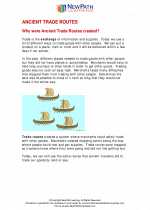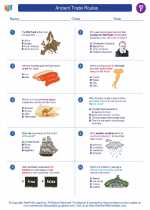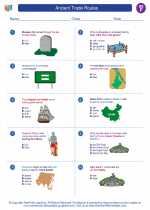Ancient Trade Routes
Trade routes created a system where merchants could safely trade with other people. Merchants created stopping points along the way where people could rest and get supplies. Trade routes were mapped so travelers knew where they were going and did not risk getting lost. Read More...
◂Social Studies Worksheets and Study Guides Sixth Grade. Ancient Trade Routes
Study Guide Ancient Trade Routes
Ancient Trade Routes  Worksheet/Answer key
Worksheet/Answer key Ancient Trade Routes
Ancient Trade Routes  Worksheet/Answer key
Worksheet/Answer key Ancient Trade Routes
Ancient Trade Routes  Worksheet/Answer key
Worksheet/Answer key Ancient Trade Routes
Ancient Trade Routes 

 Worksheet/Answer key
Worksheet/Answer key
 Worksheet/Answer key
Worksheet/Answer key
 Worksheet/Answer key
Worksheet/Answer key

The resources above cover the following skills:
National Curriculum Standards for Social Studies (NCSS)
TIME, CONTINUITY, AND CHANGE
SOCIAL STUDIES PROGRAMS SHOULD INCLUDE EXPERIENCES THAT PROVIDE FOR THE STUDY OF THE PAST AND ITS LEGACY.
KNOWLEDGE - Learners will understand:
The study of the past provides a representation of the history of communities, nations, and the world.
That learning about the past requires the interpretation of sources, and that using varied sources provides the potential for a more balanced interpretive record of the past.
That historical interpretations of the same event may differ on the basis of such factors as conflicting evidence from varied sources, national or cultural perspectives, and the point of view of the researcher.
Key historical periods and patterns of change within and across cultures (e.g., the rise and fall of ancient civilizations, the development of technology, the rise of modern nation-states, and the establishment and breakdown of colonial systems).
The contributions of key persons, groups, and events from the past and their influence on the present.
The influences of social, geographic, economic, and cultural factors an the history of local areas, states, nations, and the world.
National Center for History in Schools (NCHS)
Historical Thinking Standards
Chronological Thinking
Identify the temporal structure of a historical narrative or story.
Reconstruct patterns of historical succession and duration; explain historical continuity and change.
Historical Comprehension
Reconstruct the literal meaning of a historical passage.
Identify the central question(s) the historical narrative addresses.
Historical Analysis and Interpretation
Draw comparisons across eras and regions in order to define enduring issues.
Challenge arguments of historical inevitability.
Hold interpretations of history as tentative.
Historical Research Capabilities
Formulate historical questions.
Historical Issues-Analysis and Decision-Making
Identify issues and problems in the past.
Identify relevant historical antecedents.
United States History Content Standards
Era 1: Three Worlds Meet (Beginnings to 1620)
How early European exploration and colonization resulted in cultural and ecological interactions among previously unconnected peoples.
The student understands the stages of European oceanic and overland exploration, amid international rivalries, from the 9th to 17th centuries.
World History Content Standards
Era 2: Early Civilizations and the Emergence of Pastoral Peoples, 4000-1000 BCE
The major characteristics of civilization and how civilizations emerged in Mesopotamia, Egypt, and the Indus valley.
The student understands how Mesopotamia, Egypt, and the Indus valley became centers of dense population, urbanization, and cultural innovation in the fourth and third millennia BCE.
The student understands how commercial and cultural interactions contributed to change in the Tigris-Euphrates, Indus, and Nile regions.
Major trends in Eurasia and Africa from 4000-1000 BCE.
The student understands major trends in Eurasia and Africa from 4000 to 1000 BCE.
Era 5: Intensified Hemispheric Interactions 1000-1500 CE
The maturing of an interregional system of communication, trade, and cultural exchange in an era of Chinese economic power and Islamic expansion.
The student understands how interregional communication and trade led to intensified cultural exchanges among diverse peoples of Eurasia and Africa.
Major global trends from 1000-1500 CE.
The student understands major global trends from 1000 to 1500 CE.